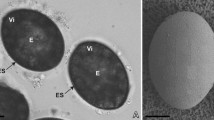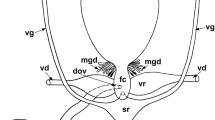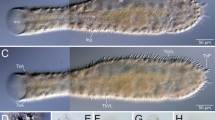Summary
The ultrastructure of active and inactive corpora allata from last instar larvae of the southwestern corn borer, Diatraea grandiosella, was examined. Active glands were obtained from pre-, early, and mid-diapausing larvae; inactive ones from late and non-diapausing larvae. Each gland contains 13 to 18 cells which have the following common features: well developed smooth endoplasmic reticulum, scattered rough endoplasmic reticulum and free ribosomes, microtubules, vacuolated nucleoli, and interlocking plasma membranes. The gland contains intercellular deposits, and is supplied by regular and neurosecretory axons.
Special ultrastructural features of the corpus allatum from the five groups of larvae examined were as follows: pre-diapause: extensive vesicular smooth endoplasmic reticulum, numerous cup-shaped mitochondria and Golgi bodies with stacked cisterns and vesicles, few small lipid droplets, large nuclei with dispersed chromatin, absence of lysosomes; early diapause: stacked, whorled, and vesicular smooth endoplasmic reticulum of equal abundance, numerous rod-shaped mitochondria, some Golgi bodies but without distinct stacks of cisterns, few lipid droplets and lysosomes, chromatin dispersed and also attached to the nuclear envelope; mid-diapause: similar to early diapause except for the presence of more stacked, smooth endoplasmic reticulum, chromatin in large chunks mostly attached to the nuclear envelope; late diapause: whorled smooth endoplasmic reticulum and rod-shaped mitochondria predominating, complicated Golgi bodies with stacks of cisterns and large empty sacs, few large lipid droplets, some lysosomes containing mainly whorled bodies, chromatin in large chunks attached to the nuclear envelope; non-diapause: similar to late diapause except for less extensive smooth endoplasmic reticulum, more abundant mitochondria, fewer intercellular deposits. Although these observations suggest that the smooth endoplasmic reticulum, and possibly mitochondria, and Golgi bodies are involved in juvenile hormone production, specific sites of synthesis or storage of the hormone were not revealed.
Similar content being viewed by others

References
Bergot, B.J., Schooley, D.A., Chippendale, G.M., Yin, C.-M.: Juvenile hormone titer determinations in the southwestern corn borer, Diatraea grandiosella, by electron capture-gas chromatography. Life Sci. 18, 811–820 (1976)
Chippendale, G.M.: Ascorbic acid: an essential nutrient for a plantfeeding insect, Diatraea grandiosella. J. Nutr. 105, 499–507 (1975)
Chippendale, G.M., Reddy, A.S.: Temperature and photoperiodic regulation of diapause of the southwestern corn borer, Diatraea grandiosella. J. Insect Physiol. 19, 1397–1408 (1973)
Deleurance, S., Charpin, P.: Evolution ultrastructurale des corps allates de la larve du dernier stade de Choleva angustata Fab. (Catopidae). Action du jeûne, en présence ou non d'ecdystérone. C. R. Acad. Sci. (Paris) 280 D, 2113–2116 (1975)
Deleurance, S., Charpin, P.: Ultrastructural dynamics of the corpus allatum of Choleva angustata Fab. (Coleoptera, Catopidae). Cell Tissue Res. 191, 151–160 (1978)
Elliot, H.J.: Structural analysis of the corpus allatum of an aphid, Aphis craccivora. J. Insect Physiol. 22, 1275–1279 (1976)
Fukuda, S., Eguchi, G., Takeuchi, S.: Histological and electron microscopical studies on sexual differences in structure of the corpora allata of the moth of the silkworm, Bombyx mori. Embryologia (Nagoya) 9, 123–158 (1968)
Guelin, M., Darjo, A.: Etude ultrastructurale des corpora allata en relation avec le contrôle photopériodique de leur fonction gonadotrope chex Locusta migratoria migratoria L. C. R. Acad. Sci. (Paris) 278 D, 491–494 (1974)
Hammock, B.D.: NADPH dependent epoxidation of methyl farnesoate to juvenile hormone in the cockroach, Blaberus giganteus L. Life Sci. 17, 323–328 (1975)
Joly, L., Joly, P., Porte, A., Girardie, A.: Etude physiologique et ultrastructurale des corpora allata de Locusta migratoria L. (Orthoptère) en phase grégaire. Arch. Zool. Exp. Gén. 109, 703–728 (1968)
Lee, E., Schooley, D.A., Hall, M.S., Judy, K.J.: Juvenile hormone biosynthesis: homomevalonate and mevalonate synthesis by insect corpus allatum enzymes. J. Chem. Soc. Chem. Comm. no. 7, 290–292 (1978)
Luft, J.H.: Improvements in epoxy resin embedding methods. J. Biophys. Biochem. Cytol. 9, 409–414 (1961)
Melnikova, E.J., Panov, A.A.: Ultrastructure of the larval corpus allatum of Hyphantrea cunea Drury (Insecta, Lepidoptera). Cell Tissue Res. 162, 395–410 (1975)
Novikoff, A.B., Holtzman, E.: Cells and organelles, 337 pp. New York: Holt, Rinehart, and Winston, Inc., 1970
Reibstein, D., Law, J.H., Bowlus, S.B., Katzenellenbogen, J.A.: Enzymatic synthesis of juvenile hormone in Manduca sexta. In: The juvenile hormones (L.I. Gilbert, ed.), p. 131–146. New York: Plenum Press (1976)
Scharrer, B.: Histophysiological studies on the corpus allatum of Leucophaea maderae: V. Ultrastructure of sites of origin and release of a distinctive cellular product. Z. Zellforsch. 120, 1–16 (1971)
Steedman, H.F.: Alcian blue: a new stain for mucin. Quart. J. Micros. Sci. 91, 477–479 (1950)
Tobe, S.S., Pratt, G.E.: Dependence of juvenile hormone release from corpus allatum on intraglandular content. Nature (Lond.) 252, 474–476 (1974)
Tobe, S.S., Saleuddin, A.S.M.: Ultrastructural localization of juvenile hormone biosynthesis by insect corpora allata. Cell Tissue Res. 183, 25–32 (1977)
Waku, H., Gilbert, L.I.: The corpora allata of the silkmoth, Hyalophora cecropia: an ultrastructural study. J. Morph. 115, 69–96 (1964)
Yin, C.-M., Chippendale, G.M.: Hormonal control of larval diapause and metamorphosis of the southwestern corn borer, Diatraea grandiosella. J. Exp. Biol. 64, 303–310 (1976)
Yin, C.-M., Chippendale, G.M.: Diapause of the southwestern corn borer, Diatraea grandiosella: further evidence showing juvenile hormone to be the regulator. J. Insect Physiol. 25, in press (1979)
Author information
Authors and Affiliations
Additional information
Supported in part by grant no. PCM 74-18155 A01 from the National Science Foundation. Contribution from the Missouri Agricultural Experiment Station as journal series no. 8234. We thank Ms. L. Yin for her skillful assistance, and Dr. M.F. Brown of the College of Agriculture Electron Microscope Facility for his advice and the use of equipment.
Rights and permissions
About this article
Cite this article
Yin, C.M., Chippendale, G.M. Ultrastructural characteristics of insect corpora allata in relation to larval diapause. Cell Tissue Res. 197, 453–461 (1979). https://doi.org/10.1007/BF00233570
Accepted:
Issue Date:
DOI: https://doi.org/10.1007/BF00233570



